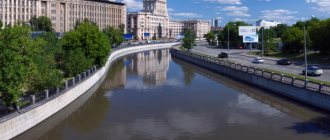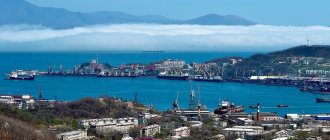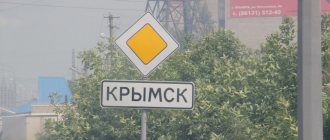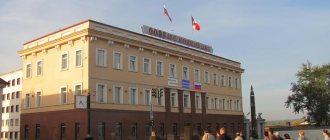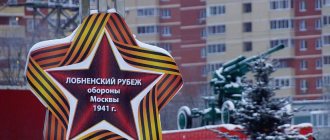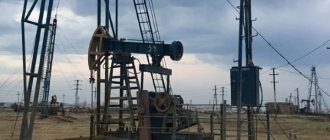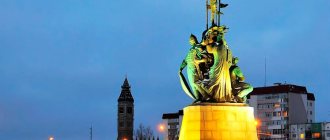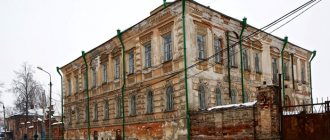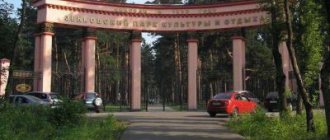Story
In ancient times, on the site of this city there was the village of Loshakovo. Over time, other settlements joined it, thus forming a volost.
At the end of the 18th century, Catherine II issued a decree according to which a gravity water supply system was to be laid from Mytishchi to Moscow. For a long time it supplied the city with water from the Mytishchi springs. The water pipeline began operating in 1804. In the 19th century, the first textile factories appeared here.
In 1860, Mytishchi turned into an important transport hub near Moscow, and the station village acquired the characteristic features of the future city. In 1896, one of the largest Russian factories for the production of carriages, which belonged to a group of industrialists, began operating in Mytishchi. In 1909, the country's first silk factory, Viscose, came into operation in Mytishchi. Soon a workers' settlement appeared near it.
In 1925, Mytishchi received official city status. A few years later, the surrounding villages were annexed to it - Sharapovo, Taininka, Rupasovo, Perlovka, Zarechnaya Sloboda.
Today Mytishchi is a modern, actively developing city. Its industry is represented by many sectors: mechanical engineering, production of finishing and building materials, light and food industries, instrument making, metalworking and others.
Dendrological Park MSUL
At 1st Institutskaya Street, 6A in Mytishchi, the Dendrological Park of Moscow State University of Linguistics is located.
The park area, covering an area of 1.46 hectares, is covered with green lawns, as well as a network of asphalt and sand and gravel paths along which you can easily get to any point in the garden.
The flora is represented by deciduous and coniferous plants, growing naturally or transplanted to provide a diversity of tree and shrub species.
Study routes involve familiarization with willows, poplars, lindens, honeysuckle, pines, cypresses, buckthorn, grape, sucker, rosaceae, heather, and horse-chestnut families. Regular soil surveys allow you to plan new plantings.
Sights of Mytishchi and description
Let's start our acquaintance with the natural monument of the city - the Yauza River. This is the left tributary of the Moscow River. The river is small, its length is 48 kilometers. It originates in the Moscow region, in the swamps of Losiny Ostrov. Ustye is located in the center of Moscow, near the Bolshoi Ustinsky Bridge. The area of the Yauza basin is 452 square meters. km.
At the beginning of the 18th century, from the mouth to Sokolniki, the banks of the Yauza were actively built up; its bed was blocked by numerous mills and dams. This greatly polluted its waters. In the 1930s, the river bed was leveled and almost doubled, granite embankments were erected along the reservoir, and new bridges appeared. The entire undeveloped part of the Yauza valley was declared a natural monument in 1991.
Dzhamgarovsky Park in Mytishchi
The picturesque park, named after the founders - the Dzhangarov brothers, is located on the street. Startovaya, 4, near the Ichka River.
The park area is planted with huge pine trees, birch trees, and linden trees. There are benches along the asphalt paths where older people and mothers with children relax.
The pond, with an area of about 13.4 hectares and a depth of up to 2.6 m, is located in the center of the park, fenced with a wooden embankment. The reservoir is home to perches, crucian carp, pike, and roach.
Sandboxes, carousels, swings, and slides have been prepared for children. Those who want to cook barbecue or spend time outdoors with friends can use gazebos equipped with barbecues.
Visitors are welcome in an entertainment area equipped with a billiards room, games room, and karaoke club. In summer they offer to go on a boat ride on gondolas, and in winter they offer ice skating.
Pestovskoye Reservoir
Another natural monument for which Mytishchi is famous. The sights of the city, which include the Pestovskoye Reservoir, were created by human hands. This is an artificial reservoir, built in 1937 during the construction of a hydroelectric complex on the Vyaz River.
The hydroelectric complex consists of a dam, 707 meters long, a catchment area and a bottom outlet. The reservoir area is 11.6 square meters. km, volume - 54.3 million cubic meters. The length of the artificial reservoir is more than six kilometers, the width exceeds two kilometers, and the depth is 14 meters.
The Pestovskoye Reservoir is part of the canal system named after. Moscow, the reservoir intersects with other reservoirs - Ikshinsky, Pyalovsky and Uchinsky. On its picturesque shores there are several marinas - Lesnoye, Tishkovo, Khvoiny Bor.
Mytishchi in the Great Patriotic War
Today, on the day of the 76th anniversary of the Great Patriotic War, we continue to publish chapters from the book of Mytishchi local historian and cyclist Sergei Egorov, “Historical Mytishchi from a bicycle.” We offer you a cycling route through the historical places of the city of Mytishchi associated with the Great War.
Until the 1960s, the city of Kaliningrad-Korolev was part of the Mytishchi district. Leonidovka was part of the Podlipki-Leonidovka group village council. Many residents who worked at the ZIK plant lived in Leonidovka. Therefore, there was only one military registration and enlistment office. Until the 1960s, people were drafted into the army, and even more so during the war, from the military registration and enlistment office of the village. Leonidovka.
The parades took place in Mytishchi. Therefore, the company’s employees gathered at the entrance and walked along the street. Lenin, Pionerskaya, Yaroslavl highway to Vokzalnaya Square in Mytishchi.
We are separated by the Yaroslavl highway, but we have a common historical memory.
Mytishchi during the Second World War.
Cycling route. Length 17 km. Mytishchi station - Silikatnaya st. - Leonidovka - st. Kolontsova - Yaroslavskoe highway - Druzhba microdistrict - Perlovskaya - Yauza recreation center.
The city of Mytishchi did not directly participate in the hostilities of the Great Patriotic War. The first line of defense of Moscow in October-November 1941 took place at a sufficient distance along the banks of the Klyazminskoye and Uchinskoye reservoirs, the Klyazma River, and the Moscow-Volga water canal. Nevertheless, the city was actively involved in ensuring the defense of Moscow: the 2nd (reserve) line of defense passed through it, elite special forces of the NKVD working in the German rear were stationed here, their schools and training camps were located, and defense enterprises operated at full capacity.
Route 4. Map 1.
We begin our cycling route on the square next to the Mytishchi railway station (on the left side of the railway from Moscow at point 1: 55.915188, 37.760308.) In 1941, recruits were sent to the front from this station. Trains with soldiers from Siberia and the Far East stopped there, who were then transferred to Moscow. Honorary citizen of Mytishchi, General A.P. Beloborodov, recalled how during a long stop of the train with troops of the 78th Infantry Division at the Mytishchi station on October 22, 1941, a meeting was organized with the participation of local residents, which strengthened the morale of soldiers and officers.
Monument to partisans on Vokzalnaya Square (not preserved). Photo 1963
From the station we move along Sharapovsky Proezd and Silikatnaya Street to building 1/9 ( point 2: 55.924144, 37.769180). In 1941, the 18th Fighter Battalion was stationed in the building of the Moscow Industrial College (now Lyceum No. 2), which not only performed security and counter-sabotage functions, but also participated in raids behind enemy lines.
The building is a former industrial college - the location of the 18th extermination battalion
We follow to point 3 (Silikatnaya, 19: 55.931394, 37.775594). This is the entrance to the enterprise of OJSC “Mostroyplastmass” (the former brick factory of the merchant Gerasimov, and since 1929 – the Silicate Brick Plant). During the war, the production of anti-tank mines was established there. In October 1943, a terrible explosion occurred at the plant, as a result of which it was completely destroyed. We cross Silikatnaya Street and approach the monument to those killed in the Second World War and in the explosion at the plant ( point 4 : 55.930691, 37.777747).
Monument to those killed in the explosion at the sand-lime brick factory
For experienced cyclists, we suggest driving to the entrance of the Dynamo shooting range ( point 5: 55.942087, 37.771645). During the war, there was a training base for the First Russian Special Forces - the Separate Special Purpose Motorized Rifle Brigade of the NKVD (OMSBON). The brigade has carried out hundreds of raids and special missions behind enemy lines, dozens of created partisan detachments, including the famous “Winners” detachment of D.N. Medvedev, in which the legendary intelligence officer N.I. Kuznetsov fought. The author's father Stepan Mikhailovich Egorov fought with the Nazis in the Frunze partisan brigade near the city of Osveya (Belarus) under the command of I.K. Zakharov. According to his recollections, part of their brigade was also formed from fighters of the Mytishchi OMSBON. Currently, the shooting range is private territory. And the question of access to it depends on the favor of the guards. You can drive around the territory from the outside, for example, to the Olympic entrance to the shooting range ( point 6 : 55.943434, 37.765424).
Not far from point 4, behind the railway, there is the Podlipki sanatorium (point 7: 55.937789, 37.810565, Yaroslavskoe highway, property 149). Here during the war there was a Hospital for 650 beds and a Higher School of Sappers and Miners for 125 people.
From point 4 we return to the beginning of Silikatnaya Street, cross the railway crossing at point 8 : 55.923474, 37.771819 and move along the street. Popova towards Yaroslavl highway. On the right side is the block of the Mytishchi city hospital, where the hospital was located during the war. At point 9: 55.924299, 37.784887 (13 Popova St.) there is a bayonet monument to those killed in the Second World War. The monument is located on the site of a one-story wooden building of the district military registration and enlistment office, in which conscription for military service was carried out during the war. More than 45 thousand of our fellow countrymen went to the front from this building.
City military commissariat in Mytishchi in the 1940s. Photo from S. Vetlin’s book “Mytishchi, the birthplace of Russian special forces.”
Monument-bayonet to those killed in the Second World War on the site of the former Mytishchi military registration and enlistment office
Following Khlebozavodskaya Street, we exit onto Yaroslavskoe Highway and climb the pedestrian bridge at point 10: 55.921323, 37.796067. From the bridge there is a view of the administrative building of artillery plant No. 88 (now RSC Energia OJSC, point 10 : 55.921762, 37.798245).
The administrative building of the former military plant ZIK N 88 (now RKK Energia) In 1941, the plant was evacuated to the Urals, and in 1942 Leningradsky was transported to its place. During the war years, the plant produced 5,400 25 mm 72-K automatic anti-aircraft guns.
Crew of the 72-K anti-aircraft automatic gun in position in 1943.
We drive along the Yaroslavl highway to the Church of the Icon of the Vladimir Mother of God ( point 11 : 55.910049, 37.774030). The church's bell tower was dismantled in 1941 so as not to serve as a landmark for enemy aircraft, and was restored only in the late 1990s.
Church of the Icon of the Vladimir Mother of God. 1713
On the left hand we pass the site of the former airfield of the Headquarters of the Supreme High Command ( point 12 : 55.911582, 37.784523). It was from this airfield that OMSBON sabotage and partisan groups were most often delivered behind enemy lines.
Airfield of the Headquarters of the Supreme High Command. German filming 1942
We drive 800 meters to the entrance of OJSC "Metrovagonmash" st. Kolontsova, 6, point 13 : 55.910457, 37.765751. The plant, which hid under number 592 during the war, was evacuated to Ust-Katav in October 1941. Despite the evacuation, armored caps and anti-tank hedgehogs continued to be produced on its territory. And since 1943, using new equipment, the plant began to produce self-propelled artillery units SU-76, which became famous in the battles on the Kursk Bulge. The monument to the legendary self-propelled gun rises opposite the entrance of the plant.
Self-propelled gun SU-76 at the entrance of OJSC Metrovagonmash
SU-76 in Berlin
SU-76 in combat
At the neighboring enterprise, the Viskosa factory (5 Kolontsova St., point 14: 55.913395, 37.763674), the production of parachute silk and lines was established. And since 1943 - cellophane - film that was urgently needed at the front.
We return to the Yaroslavl highway along Kolontsova Street, which in the 1940s was the main street of Mytishchi, and military parades and demonstrations were often held there.
Military parade on Kolontsova Street in the 1940s
We cross the Yauza along the pedestrian bridge and follow the sidewalk along the highway (unfortunately, it is not finished everywhere yet) towards Moscow to another example of defense products of the former plant No. 592 - the Shilka self-propelled anti-aircraft gun ( Point 15: 55.903611, 37.759265).
Anti-aircraft gun ZSU-23-4 "Shilka"
Route 4. Map 2
We continue driving behind the noise barrier to the overpass ( point 16 : 55.892152, 37.743443). We cross to the other side of the highway and along 1st Parkovaya and Krasina streets we approach the Church of St. Nicholas the Wonderworker, consecrated in 2003 ( point 17: 55.889713, 37.750065). On the site near the temple there are two reinforced concrete fireplaces (reinforced concrete firing point). One has been preserved in this place since the Second World War. At that time there was no church, no shopping center, and a significant section of the Yaroslavl highway was freely shot from the reinforced concrete construction. The second ZhBOT was recently “rescued” by local historians from the swamps of Losiny Ostrov.
Reinforced concrete pillbox near the Church of St. Nicholas the Wonderworker
Reinforced concrete pillbox near the Church of St. Nicholas the Wonderworker
We return to point 16 and along the streets 5th Yaroslavsky Lane, Pozharny Proezd, 2nd Baumanskaya, 1st Vokzalnaya we continue moving towards the Perlovskaya platform. We cross the railway along a pedestrian crossing, and to the right of it we see another reinforced concrete guard, guarding the approaches to the railway ( point 18 : 55.893094, 37.730223).
Reinforced concrete bunker near the Perlovskaya platform
Approximately 400 meters northeast of ZhBOT at point 19: 55.896394, 37.734874 in the sanatorium named after. Semashko (now does not exist) housed the Military Hospital.
Along the street of Hero of Russia Vera Voloshina, a student at the Institute of Cooperation, who repeated the feat of her friend Zoya Kosmodemyanskaya, and was executed on the same day as her - November 29, 1941 (the monument-bust to the hero is located at coordinates 55.893464, 37.725117, Semashko Street, 22), we are moving towards the second line of defense of Moscow, which took place in Mytishchi along the Yauza River. We turn right onto 1st Krestyanskaya Street, and then onto Sosnovaya. Here, at point 20 : 55.897186, 37.727002, one of the reinforced concrete tanks that defended this line was preserved.
Reinforced concrete bunker on the bank of the Yauza at point 20
From point 20 you can make a radial exit from the route to the former territory of the Mytishchi airfield of OSOAVIAKHIM. In 1941, the airfield was subordinated to the NKVD and was used to send sabotage groups behind Nazi lines and train paratroopers. The site of the airfield is immortalized by a monument to the PO-2 aircraft ( point 21: 55.903420, 37.714788).
Monument to the PO-2 aircraft
The monument can be reached along 1st Krestyanskaya, Sukromka, Letnaya streets. The eastern border of the airfield ran along Letnaya Street, and the western border approximately along the street. Anniversary. At the intersection of the latter with Veterans Boulevard, a monument was erected to the Honorary Citizen of Mytishchi, Hero of the Soviet Union, pilot, “night witch” N.M. Raspopova ( point 22 : 55.910854, 37.715094).
Monument to N.M. Raspopova
We continue moving along the Frontier of Defense to the north along the recently opened bicycle path along the Yauza, then along the streets Naberezhnaya, Rabochaya, Mira to another well-preserved reinforced concrete plant at point 23: 55.906385, 37.743090.
Reinforced concrete works near Mira street
The route ends at the Military Memorial of Mytishchi at point 24 : 55.907721, 37.742485. The memorial complex was opened on May 9, 1995, and on May 9, 2005, the Eternal Flame was lit at the foot of the majestic stele. Let us bow to the fallen heroes and honor their memory with a minute of silence.
War memorial in Mytishchi
In describing the route, we did not mention several important objects of the city's air defense: anti-aircraft gun positions at the Yauza Palace of Culture, the FEST theater, school No. 25, on Furazhnaya Street; floodlight installations near school No. 25 and on the modern territory of the Russian University of Cooperation, balloon barriers in the area of the Perlovskaya platform; one of the first radar stations in the USSR “Redut 40”, which operated near the village of Yadreevo (in 1941 there were only two of them near Moscow). There are practically no traces of them left. We can only approximately name the place where they were.
The first Soviet radar station is on duty. Photo 1941
Sergey Egorov, member of the Union of Local Historians, member of the Public Chamber of the Mytishchi Urban District
Sources:
- From the book “Historical Mytishchi from a bicycle” by Sergei Egorov (forthcoming).
You can also read in the newspaper “A Week in the District”:
- No. 17 from 6.5-12.5.2017 “Mytishchi in the Second World War.” Cycling route part 1.
- No. 18 from 13.5-19.5.2017 “Mytishchi in the Second World War.” Cycling route part 2.
Views: 11,002
Church of the Annunciation of the Virgin Mary
The sights of Mytishchi are, of course, unique religious buildings. An amazingly beautiful monument of church architecture can be seen in this town near Moscow - the snow-white Church of the Annunciation of the Virgin Mary. The staircases are made in an original way - they resemble the entrance to a wooden fairy-tale tower. Two symmetrical spans rise to platforms that are crowned by tents.
This magnificent stone cathedral appeared in 1677 on the site of a wooden structure. In 1812 the temple was badly damaged. And in Soviet times, his fate was not easy. Like the main attractions of the city of Mytishchi, related to religious architecture, it was closed in 1924. Its premises were used as a meat shop, a warehouse, and a dormitory. The temple returned to the Orthodox Church in 1989.
Church of the Life-Giving Trinity
Residents of the city of Mytishchi are very sensitive to monuments. Attractions of interest to tourists appeared here at different times. For example, the Church of the Life-Giving Trinity is located on the site where the Donskaya Church was built in 1896. After it was closed in the 30s, it was empty for a long time and gradually collapsed.
In October 1994, the Orthodox parish of the temple was officially registered again. The new one-story building was built in 2004 from wood. Next to it stands a bell tower. The temple is crowned with a dome with a cross. Today it houses a house church and a cultural and educational center. There is a Sunday school at the church. Here you can practice choral singing, embroidery, beadwork, and icon painting.
Travel tips
Religious, architectural and cultural attractions of Mytishchi are available for exploration in both winter and summer. It is better to visit natural monuments in the warm season. Therefore, you should choose the period of your trip in connection with the goals you are pursuing.
How long does it take to look around Mytishchi?
You should set aside two to three days to get acquainted with all the significant places of the city:
Since you will have to spend more than one day in the city, you should book a hotel in advance. There are quite a few hotels in Mytishchi, and given the proximity to Moscow, you can spend the night in the capital.
What to bring as a souvenir
Tourists bring a variety of souvenirs from Mytishchi:
Drama theatre
Anyone who comes to Mytishchi can choose the attractions to suit their taste. Theatergoers will certainly be pleased to visit the FEST Theater. It appeared in 1977. This is the main theater of Mytishchi, which has been professional since 1988. Its history began in 1976, when the Komsomol committee of the MLTI announced an amateur art competition, in which the faculties of the Forestry Engineering Institute took part. Electronics students named their team "FEST". They presented the audience with the production “With Chile in Heart”. The performance featured then unknown, but today famous, E. Kurashov, O. Vinokurov, E. Tsvetkova, M. Zaslavsky, S. Demidov, P. Grishin. The boys took first place in the competition. Since that time, the FEST propaganda team appeared in the city.
Monument to the water supply
There is a monument in the city that amazes everyone who comes to Mytishchi. The city's attractions (you can see photos in this article) can claim to be the most original. First of all, this concerns the structure erected in honor of the bicentenary of the first water pipeline.
An unusual monument was erected at the entrance to the city, from the Volkovskoye Highway. It was conceived as an object of street design, as it has interesting views when approaching it from different sides. When approaching it, it seems that it is growing out of the ground, and the closer you get to it, the larger it becomes.
The composition, 18 meters high, consists of three pipes, which are crowned with water valves. The structure is installed on a circle with a diameter of sixty meters. There is a hill in this area. On one side it is planted with low-growing shrubs. The rest of the area is planted with a variety of plants, so the hill is constantly in bloom.
The monument still causes controversy over its architectural and aesthetic value. Nevertheless, the main goal set for its creators has been achieved; the monument does not leave anyone indifferent. Today it is not only the calling card of the city, but also one of the most original monuments in the country.
Seven main monuments of Mytishchi: a route through the sights of the city
An eight-meter samovar, the wizard Ole Lukoye, a Po-2 plane taking off, a formidable janitor, water pipes... The monuments of Mytishchi are famous for their unusualness and creative design, and one of them was even included in the register of the most original monuments in the country. What sculptures and art objects can be found on the streets of the city, read the material “RIAMO in Mytishchi”.
Samovar
GPS coordinates: 55.921967, 37.711164
At the entrance to the city from Volkovskoye Highway, at the intersection of Borisovka and Mira streets, a huge sculpture-fountain in the form of a samovar hospitably flaunts. A kettle is installed on the “head”, and under the spout there is a cup into which water is collected during the warm season.
The author of the 8-meter composition is Mytishchi artist Alexander Vashchenko.
The shape of the samovar was chosen to be classic – the same as in Vasily Perov’s painting “Tea Party in Mytishchi”.
The color of the sculpture is copper, the handles are folding - everything is like a real antique samovar.
It is interesting that the hill on which the monument stands was designed in the shape of the famous Zhostovo tray - another symbol of Mytishchi. The birthplace of this folk craft is the village of Zhostovo, located on the territory of the urban district.
Monument to the water supply
GPS coordinates: 55.916915, 37.725073
We move further into the city and at the intersection of Mira and Yubileinaya streets we see a monument to the Mytishchi water supply system. This work by architect Dmitry Zaitsev is known throughout Russia: the composition is included in the register of the most original monuments in the country.
The architectural object in the form of three metal pipes with technical valves in red, yellow and green colors was opened in 2004 - on the bicentenary of the first Russian water pipeline. It was laid from Mytishchi to Moscow by order of Empress Catherine II and began operating in 1804. Thus, the monument is dedicated to an important event in the history of Russia.
At the foot of the composition there are granite stones - a symbol of the earth, which opened up under the pressure of water.
This artistic solution is a reference to the legend about the Thunder Spring - a natural spring that was formed in the vicinity of the city of Mytishchi from a lightning strike.
And the floral decorations at the base of the monument symbolize the transformation of the water element into a water supply system, which gives the townspeople comfortable living conditions.
Airplane Po-2
GPS coordinates: 55.903279, 37.714669
The next interesting monument is located at the intersection of Letnaya and Sukromka streets. The Po-2 aircraft on an impressive pedestal is dedicated to the feat of the pilots of the Mytishchi flying club, which was founded in 1936 and trained more than 300 pilots who flew this aircraft model. During World War II, the Po-2 served as a night bomber, liaison, and reconnaissance aircraft.
According to the author of the monument, Mytishchi artist Valery Androsov, a life-size model of the aircraft is located on a spiral-shaped 21-meter pedestal in the form of a runway. The golden color of the plane itself was not chosen by chance - it symbolizes the Star of the Hero of the Soviet Union, which was awarded to graduates of the Mytishchi flying club.
Rook
GPS coordinates: 55.907214, 37.742485
One of the most important monuments of Mytishchi is, without a doubt, the wooden boat. This is the symbol of the city, which is also depicted on its flag and coat of arms. A life-size copy of an ancient Russian boat appeared on the banks of the Yauza River in September 2009 - at the Day of the City of Mytishchi.
In the Middle Ages, the boat was the main means of transportation on water. Since the 15th century, on the territory of modern Mytishchi, there was a transfer point between the Yauza and Klyazma rivers, with the help of which it was possible to make a water trip from Moscow to Vladimir. There they collected a duty from traders - “myt”. Hence the name “Yauz Mytishche”, which then went to the village, and then to the city.
Gabrovo cat
GPS coordinates: 55.908553, 37.745560
After the symbol of Mytishchi, you can admire the symbol of the partner city. To do this, you need to go to the alley in the Central City Park near the pier. There is a sculpture “Gabrovskaya Cat”.
A cat without a tail is the symbol of the city of Gabrovo, Bulgaria.
The sculpture was donated to Mytishchi in honor of ten years of business relations between the cities.
The grand opening of the composition, authored by Adrian Novakov, took place on August 31, 2013. The inscription on the pedestal translated from Bulgarian means: “The world survived because it laughed.”
The city of Gabrovo is considered the Bulgarian “capital of humor”. The House of Humor and Satire is located there; themed fun festivals are regularly held. And the Bulgarian cat with a cheerful motto helps the residents of Mytishchi not to lose heart even in the most inclement weather.
Ole Lukoje
GPS coordinates: 55.913317, 37.750356
The good mood of Mytishchi residents is protected not only by a representative of the cat family, but also by a popular fairy-tale character - Ole Lukoie. According to Andersen's fairy tale, based on folk legends, this kind wizard shows children vivid dreams.
The sculpture of the soaring Ole Lukoje is located near the building of the Ognivo puppet theater.
He greets the audience by opening a magic umbrella. He also holds a doll - this is a thematic reference to the theater and its fairy-tale characters.
Ole Lukoye appeared in Mytishchi in 2004, when the Ognivo theater again opened its doors to visitors after reconstruction. Near the sculpture you can often see children playing, happy newlyweds and curious tourists.
The author of the monument is Vladimir Trulov. He prudently chose fiberglass as a material for the pedestal, which is durable and does not require special care. So Ole Lukoje will hover under the umbrella for many years and delight the townspeople.
Street cleaner
GPS coordinates: 55.911415, 37.734374
Walking along Mira Street, it is impossible to pass by one very colorful character. He is dressed in a short fur coat, a hat with earflaps on his head, and massive boots on his feet. In one hand there is a broom, and with the other he points at passers-by, looking at them menacingly with steely eyes. “Did you pick up the trash after yourself?” – reads a stern inscription on the base of the art object.
A harsh but fair janitor was installed by order of the waste disposal company Spetsremtrans OJSC directly opposite its office.
Very symbolic and humorous!
"Kva-Kva Park"
Guests of the city enjoy exploring its main attractions. Mytishchi, or rather, its residents are very proud of the Kva-Kva Park. It is located in the shopping and entertainment district.
Both children and adults love to relax in this water park. Here you can ride the “Wild River” slide, rush through the “Cyclone” aquadrome, and experience all the delights of the “Black Hole”.
The six-hundred-meter wave pool pumps adults and children on artificial waves like ocean surf. Children most of all love the attractions in the "Children's Town", and adults who love a relaxing holiday will enjoy relaxing in the spa complex with a Finnish sauna, a Japanese plunge pool, a Russian bath and a solarium. The Etazh bar will offer you light snacks, and for those who are really hungry, we recommend going to the Troya restaurant, where you can have a hearty and inexpensive lunch.
What to see if you come with a child
In Mytishchi there are many different places that will not let little travelers get bored.
Einstein Museum
One of the city's shopping centers contains the Einstein Museum on its square, opening in 2021. The guides introduce the children to the laws of physics in a playful way:
The exposition of the institution includes 50 exhibits that can be touched, turned on and experimented with. You can also take a developmental quest if you wish.
Address: Kommunisticheskaya street, building 1, shopping center XL. Opening hours: 12.00–20.00, Saturday and Sunday – 10.00–20.00. The cost of visiting is 350 rubles.
Puppet theater "Ognivo"
The Ognivo puppet theater, opened at the beginning of the 20th century, will be a fascinating place for kids. Every year, about 16 thousand young spectators attend the theater's performances. At the entrance to the establishment there is a monument to “Ole Lukoje”, depicting a character from a famous fairy tale.
The Ole-Lukoje monument is a symbol of the Ognivo puppet theater
Address: Sharapovskaya street, 4/1. Ticket prices start from 340 rubles.
Water park "Kva-kva park"
The Kva-kva Park water park will not leave indifferent not only the child, but also his parents. The total area of the entertainment center is more than 4 thousand meters. There are slides of various lengths and heights, swimming pools and attractions. For very young children there is a children's playground where you can learn swimming.
Water park “Kva-kva park” is a favorite vacation spot for local residents and city guests
Address: Kommunisticheskaya street, building 1, shopping center XL. Opening hours: 9.00–22.00. Ticket prices start from 650 rubles.
Ice Arena "Mytishchi"
For young sports fans, the city has the Mytishchi Ice Arena. It was built in 2006 and is the largest sports facility in Mytishchi. In addition, the arena ranks among the best in all of Russia. Here you can go ice skating with the whole family, as well as visit one of the local cafes or restaurants.
Mytishchi Arena seats 7 thousand people
Address: Letnaya street, building 17. Skate rental - 150 rubles per hour; entrance ticket to the arena for adults - from 250 rubles, for children - from 100 rubles.
"Mytishchi Arena"
Arriving in Mytishchi, whose attractions are varied, you will probably want to relax after your excursions in the modern sports and entertainment complex “Mytishchi Arena”.
The palace can accommodate nine thousand spectators. Conditions have been created here so that people of any age can engage in sports such as hockey or figure skating.
The first stone of the Mytishchi Arena was solemnly laid in the spring of 2002. And it was put into operation in mid-October 2005. The building of the complex is distinguished by its original architectural design. The facades are made of metal with a large glass area. The project of Skanska East Europe Oy (Finland) became the starting point for construction, but then it was finalized by the Mosoblstroyproekt design institute. As a result, a complex was built that meets international standards.
The palace has two ice stadiums, each with an area of 1800 square meters. In addition, there are six buffets, a restaurant, a bar, six banquet halls and twenty-six VIP boxes.
We have not told you about all the sights and memorable places of Mytishchi. Therefore, if you have such an opportunity, come to this glorious city. We are confident that you will enjoy your trip.
